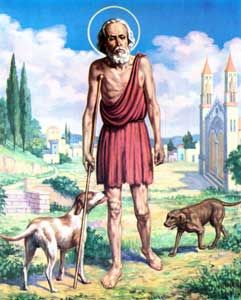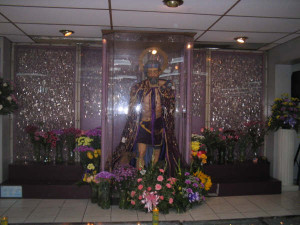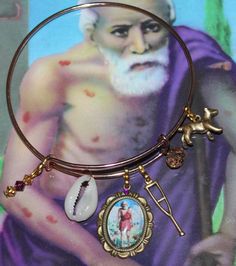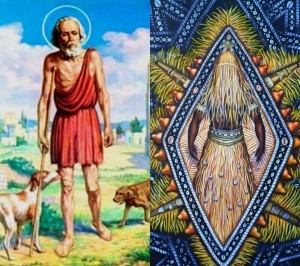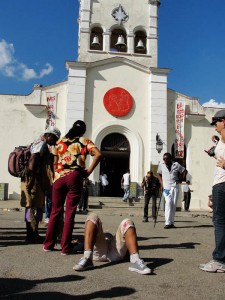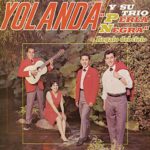 LA “NOCHEBUENA” EN CUBA. IMPORTANTE CELEBRACIÓN.
LA “NOCHEBUENA” EN CUBA. IMPORTANTE CELEBRACIÓN.
Poco después de la llegada de los españoles a Cuba, ya las tradiciones navideñas integraron nuestro patrimonio religioso y cultural. Estas tradiciones responden a una cultura heredada, pero muy pronto adaptada a las condiciones propias de nuestro país.
Fueron los colonizadores españoles los que introdujeron la cría del cerdo en Cuba y el cerdo, puerco o macho, asado, como quiera que se le llame, se convirtió en el protagonista de la Navidad cubana. En las ciudades se utilizan generalmente las piernas o las paletas, pero donde las condiciones son más propicias se le cría, o compra, para sacrificarle en tal importante celebración.
En Cuba, después de la cena, muchos concurrían a la “Misa de Gallo”. Pero a partir de 1969 las fiestas fueron eliminadas oficialmente y no fue hasta la visita del Papa Juan Pablo II, que en diciembre de 1997 se volvió a declarar el 25 de diciembre como día feriado no laborable. No obstante durante esos 28 años en muchos hogares cristianos se adoraba en la intimidad el nacimiento del Niño Jesús, y se recordaban a los Reyes Magos del Oriente.
Pero como la comida es una parte importante de la tradición navideña cubana, lo que si nunca dejó de celebrarse, de una u otra forma, fue la “cena de Nochebuena”. Y los cubanos de la Isla, con esfuerzo, esa noche siempre ponen en su mesa todo lo mejor que pueden conseguir….que para eso estaba el mercado negro. Por suerte ahora ya existen los mercados, los “agro”, y aunque los productos les resulten demasiado caros, no sé como lo hacen, pero los compran.
La comida tradicional de nuestras mesas el 24 de diciembre es el lechón asado, arroz congrí o arroz y frijoles, viandas (yuca, malanga, boniato) con mojo criollo a base de naranja agria, grasa de puerco y mucho ajo. También acompañan ensaladas o plátanos fritos maduros o verdes en versión de mariquitas o tostones.
Los dulces no faltan en la mesa navideña. Según el gusto, o las posibilidades, se comen turrones de yema, alicante, jijona, frutas u otros o de producción casera como el dulce de coco, los cascos de guayaba o naranja, el boniatillo, la calabacita china.
Lo más tradicional, que no podía faltar, eran los buñuelos. En forma de ocho, eran confeccionados a partir de una base hecha de viandas y harina, después fritos y servidos en almíbar o acompañado por algunos de los otros postres caseros antes mencionados. Al servirlos se bañaban con un almíbar de azúcar y anís. Los postres, que con tanto esmero hacían nuestras abuelas, han pasado de generación en generación y también forman parte de la tradición en las celebraciones navideñas cubanas.
Con frecuencia, la fiesta comenzaba desde la noche del 23, cuando las madres adobaban el lechón y ponían en remojo los frijoles negros. En la mañana del 24, muy temprano, en el campo, o en casas con patio, se preparaban las condiciones para asarlo. Se preparaba el “horno” en la tierra y se procedía al asado, ya fuese “al pincho” o sobre un bastidor de metal improvisado. El puerco se colocaba sobre una camada de hojas de guayaba, labor casi siempre a cargo del hombre de la casa y de los hijos varones. Y por supuesto, acompañada esta labor por abundante cerveza, los sabrosos “chicharrones” y las tan exquisitas “masitas fritas”.
El lechón era el anfitrión de la comida y cocinarlo era todo un ritual. Se asaba la pieza o el animal entero según eran las posibilidades económicas. Mientras se asaba, se untaba con mojo para que adquiriese ese sabor que cuesta olvidar. Ese adobo que permite el sabor y olor tan característico de la Nochebuena cubana. Y aunque cada familia poseía su “mojo especial”, era común la naranja agria, especias y sal. Al menos yo no conozco mejor aliño que la tradicional mezcla de ajo y sal en el mortero, para tener al final esa pasta media blanca-amarillenta, y entonces sumarlo al jugo de la naranja agria con algo de pimienta negra molida y hojas de laurel…
En la parte occidental de la Isla, existía una variante: “la caja cubana” , que es una de las pocas formas de asado en que el carbón o braza va encima y no debajo de la carne; y ambos cerrados casi herméticos y mejor aun enterrados. Es, según dicen, como mejor queda la piel del lechón y es algo para chuparse los dedos, por lo crujiente y suave de la piel al terminar.
También podía llevarse el lechón a las panaderías, donde por un mínimo precio, lograban en sus hornos una cocción perfecta. Aunque realmente el placer era hacerlo en casa y eso formaba parte de la tradición y la fiesta…
Las tradiciones Navideñas, parte del patrimonio religioso y cultural de nuestro pueblo, están arraigadas en su memoria histórica. Fue y es la temporada festiva más esperada por los cubanos. Por su aceptación casi universal, la Navidad es la única celebración que impone normas similares a gentes de diversas culturas, idiomas y razas.
A pesar de la influencia norteamericana, en Cuba la Navidad se celebraba a la española por herencia de nuestros antepasados. Desde los días previos a la Nochebuena hasta Reyes eran días mágicos de planeamiento, de compras de víveres, regalos y envío de tarjetas postales. Se decoraban los hogares, las tiendas, calles y ciudades, rebosantes de luces y colores.
La cena de Nochebuena era una de las fiestas familiares más importante del año, y ya fuera una cena íntima entre pocas personas, o una enorme fiesta familiar, era la ocasión para reunir la familia, sentarnos juntos, conversar, vernos. Y esos recuerdos son imposibles de olvidar…
Hoy reunir toda la familia es casi imposible, pero estemos donde estemos, celebramos la Nochebuena y de seguro que nuestros seres queridos están con nosotros, al menos en nuestros recuerdos y nuestros corazones.
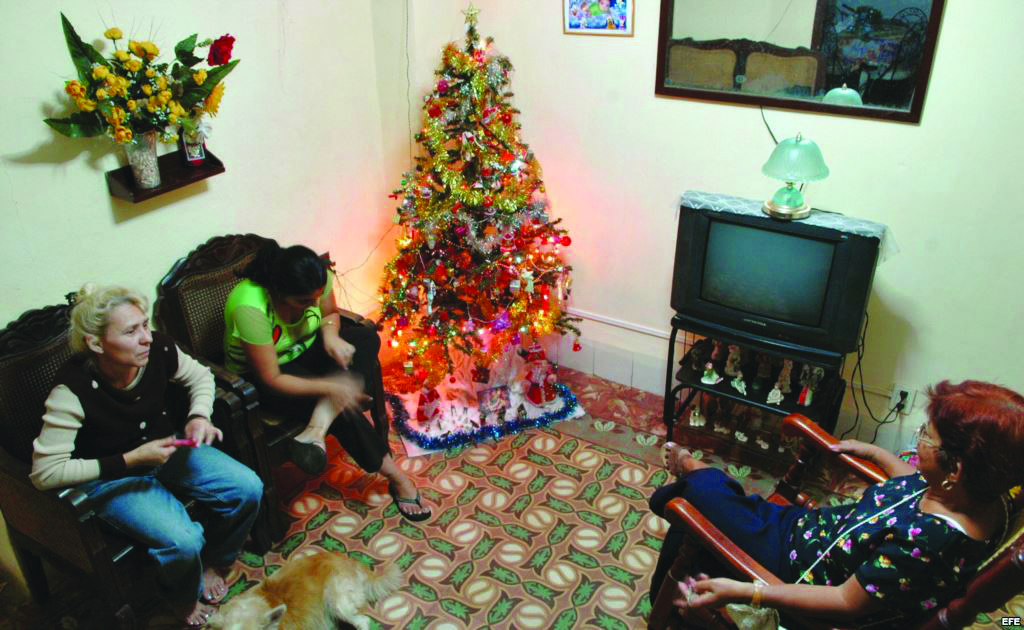 CELEBRATION OF THE “NOCHEBUENA” IN CUBA.AN IMPORTANT EVENT.
CELEBRATION OF THE “NOCHEBUENA” IN CUBA.AN IMPORTANT EVENT.
Shortly after the arrival of the Spaniards in Cuba, the Christmas traditions integrated our religious and cultural heritage. These traditions respond to an inherited culture, but very soon adapted to the conditions of our country.
It was the Spanish colonizers who introduced pig farming in Cuba and the pig, pork or male, roasted, whatever it is called, became the protagonist of Cuban Christmas. In the cities the legs or the paddles are generally used, but where the conditions are more propitious they are raised, or bought, to sacrifice him in such an important celebration.
In Cuba, after dinner, many attended the “Misa de Gallo”. But from 1969 the festivities were officially eliminated and it was not until the visit of Pope John Paul II, that in December of 1997 it was declared again on December 25 as a non-working holiday. However, during those 28 years in many Christian homes, the birth of the Child Jesus was adored in intimacy, and the Magi of the East were remembered.
But since food is an important part of the Cuban Christmas tradition, what never ceased to be celebrated, in one way or another, was the “Christmas Eve dinner”. And the Cubans of the Island, with effort, that night always put on their table all the best they can get … .that’s what the black market was for. Luckily now there are markets, the “agro”, and although the products are too expensive, I do not know how they do it, but they buy them.
The traditional food of our tables on December 24 is the roasted suckling pig, rice congrí or rice and beans, meats (yucca, taro, sweet potato) with mojo criollo based on sour orange, pork fat and lots of garlic. They also accompany salads or fried plantains ripe or green in the version of ladybugs or tostones.
The sweets are not missing at the Christmas table. Depending on the taste, or the possibilities, you can eat yolks, alicante, jijona, fruits or other homemade products such as coconut candy, guava or orange hulls, boniatillo, Chinese zucchini.
The most traditional, which could not miss, were the fritters. In form of eight, they were made from a base made of meats and flour, then fried and served in syrup or accompanied by some of the other homemade desserts mentioned above. When they were served they bathed with a sugar syrup and anise. The desserts, which our grandmothers so painstakingly made, have been passed on from generation to generation and are also part of the tradition in the Cuban Christmas celebrations.
Often, the party began from the night of the 23rd, when the mothers marinated the piglet and soaked the black beans. On the morning of the 24th, very early in the field, or in houses with a patio, the conditions for roasting were prepared. The “oven” was prepared on the ground and roasted, either “on the skewer” or on an improvised metal frame. The pig was placed on a litter of guava leaves, almost always in charge of the man of the house and the sons. And of course, accompanied this work by abundant beer, the tasty “chicharrones” and the exquisite “fried chips”.
The piglet was the host of the meal and cooking it was a ritual. The piece or the whole animal was roasted according to the economic possibilities. While it was roasting, it was smeared with mojo so that it would acquire that flavor that is hard to forget. That marinade that allows the flavor and smell so characteristic of Cuban Christmas Eve. And although each family had its “special mojo,” sour orange, spices and salt were common. At least I do not know better dressing than the traditional mixture of garlic and salt in the mortar, to have at the end that half-yellowish-white paste, and then add it to the juice of the sour orange with some ground black pepper and bay leaves …
In the western part of the island, there was a variant: “the Cuban box”, which is one of the few forms of roast in which the charcoal or breasts go over and not under the meat; and both closed almost hermetic and better yet buried. It is, they say, how best the skin of the piglet is and it is something to lick your fingers for, because of the crisp and soft skin at the end.
You could also take the piglet to the bakeries, where for a minimum price, achieved in their ovens a perfect cooking. Although really the pleasure was to do it at home and that was part of the tradition and the party …
CELEBRATION OF THE NOCHEBUENA.
The Christmas traditions, part of the religious and cultural heritage of our people, are rooted in its historical memory. It was and is the most awaited festive season for the Cubans. Because of its almost universal acceptance, Christmas is the only celebration that imposes similar norms to people of different cultures, languages and races.
In spite of the North American influence, in Cuba Christmas was celebrated to the Spanish by inheritance of our ancestors. From the days before Christmas Eve to Kings were magical days of planning, grocery shopping, gifts and sending postcards. Homes, shops, streets and cities were decorated, brimming with lights and colors.
The Christmas Eve dinner was one of the most important family parties of the year, and whether it was an intimate dinner among a few people or a huge family party, it was the occasion to gather the family, sit down together, talk, see each other. And those memories are impossible to forget …
Today gathering the whole family is almost impossible, but wherever we are, we celebrate Christmas Eve and surely our loved ones are with us, at least in our memories and our hearts.
Agencies/Memorias Cubanas/ Derubín Jácome/ Internet Photos/ Arnoldo Varona/ TheCubanHistory.com
THE CUBAN HISTORY, HOLLYWOOD.











